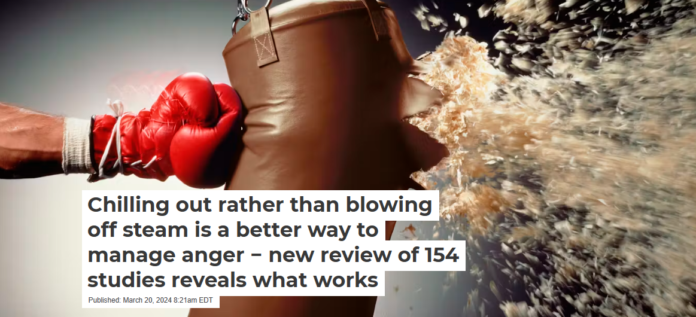

Sophie L. Kjaervik, Virginia Commonwealth University and Brad Bushman, The Ohio State University
Some commonly recommended tactics for managing anger, including hitting a punching bag, jogging and cycling, aren’t effective at helping people cool off. That’s the key takeaway of our new review of 154 studies that looked at how activities that increase versus decrease physiological arousal affect anger and aggression.
Arousal is how researchers like us describe how alert and energized someone is. When you’re in a state of high physiological arousal, you’ll have increased heart rate, blood pressure, breathing rate and skin conductance due to sweat gland activity. Anger is a negative emotion associated with high physiological arousal.
In our study, we found that activities that influence arousal levels had a profound impact on anger and aggression.
By engaging in activities that decrease arousal, such as deep breathing, muscle relaxation, yoga, meditation and mindfulness, you can control, or “turn down,” your angry feelings and aggressive impulses.
Crucially, our meta-analysis of participants from multiple studies found that activities that help decrease arousal worked across diverse settings, including in the laboratory and in real-world situations, both offline and online, and in both group and individual sessions.
In addition, activities that turn down arousal were effective for a wide variety of people – students and nonstudents, criminal offenders and nonoffenders, those with and without disabilities, and for participants of various genders, races, ages and countries.
In contrast, some activities people use to manage their anger amp up arousal and increase anger and aggression levels. Jogging, a popular stress-relief activity, actually increased anger in the studies we looked at. The repetitive nature of jogging may induce feelings of monotony and frustration, potentially exacerbating anger rather than alleviating it. Conversely, engaging in ball sports and physical education classes decreased anger, possibly because they are playful group activities that evoke positive emotions.
Likewise, venting anger increased anger and aggression. This research helps dispel the myth that it is good to blow off steam and “let it out” or “get it off your chest.” Skip screaming into your pillow or pounding on a punching bag. Save your money rather than going to a rage room to break stuff with baseball bats. Such activities are not therapeutic.

Why it matters
Anger is a common emotion with potentially destructive consequences. From physical confrontations to road rage incidents, anger is widely seen as a problem and an emotion that people should try to rein in.
Yet, most people do not have effective techniques for controlling their anger. There is a great need for identifying effective strategies for reducing and managing anger. Our study shows that activities that decrease arousal are highly effective. Many of these activities are also inexpensive or free.
In a world grappling with the dangers of unchecked anger, our research empowers people with evidence-based tools for effective anger management, fostering healthier outcomes and societal well-being.
How we do our work
Our study in the journal Clinical Psychology Review was a meta-analytic review. It combined data from 154 studies examining activities that either decrease or increase arousal and their impact on anger and aggression.
The conclusions from a meta-analysis are statistically stronger because of the large sample – in our case, 10,186 participants. A meta-analysis can also reveal patterns that are less obvious in any single study. By zooming out from a leaf, you get to see the full tree.
Sophie L. Kjaervik, Postdoctoral Fellow at The Injury and Violence Prevention Program, Virginia Commonwealth University and Brad Bushman, Professor of Communication, The Ohio State University
This article is republished from The Conversation under a Creative Commons license. Read the original article.



















